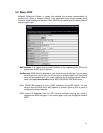
23
Authentication Type: There are two authentication types: "Open System" and "Shared
Key". When you select "Open System", wireless stations can associate with this
wireless router without WEP encryption. When you select "Shared Key", you should
also setup a WEP key in the "Encryption" page. After this has been done, make
sure the wireless clients that you want to connect to the device are also setup with the
same encryption key.
Key Length: You can select the WEP key length for encryption, 64-bit or 128-bit. The
larger the key will be the higher level of security is used, but the throughput will be
lower.
Key Type: You may select ASCII Characters (alphanumeric format) or Hexadecimal Digits
(in the "A-F", "a-f" and "0-9" range) to be the WEP Key.
Key1 - Key4: The WEP keys are used to encrypt data transmitted in the wireless network.
Use the following rules to setup a WEP key on the device. 64-bit WEP: input 10-digits
Hex values (in the "A-F", "a-f" and "0-9" range) or 5-digit ASCII character as the
encryption keys.
128-bit WEP: input 26-digit Hex values (in the "A-F", "a-f" and "0-9" range) or 13-digit
ASCII characters as the encryption keys.
Click Apply at the bottom of the screen to save the above configurations. You can now
configure other sections by choosing Continue, or choose Apply to apply the settings and
reboot the device.
WPA Pre-Shared Key Encryption
Wi-Fi Protected Access (WPA) is an advanced security standard. You can use a
pre-shared key to authenticate wireless stations and encrypt data during communication. It
supports TKIP (WPA-PSK) or AES (WPA2-PSK) encryptions; this is the best security
available.


















